
Spring Semester, 2004
Some Java GUI
© 2004, All Rights Reserved, SDSU & Roger Whitney
San Diego State University -- This page last updated 20-Jan-04

|
CS 580 Client-Server Spring Semester, 2004 Some Java GUI |
|
|---|---|---|
|
© 2004, All Rights Reserved, SDSU & Roger Whitney San Diego State University -- This page last updated 20-Jan-04 |
Building GUIs - Abstract Window Toolkit (AWT)
Types of things in AWT
Components
Graphics 101
Window Coordinate System
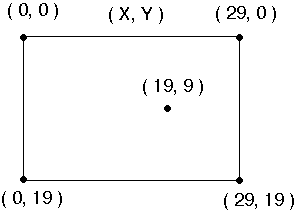
First Example This example shows a simple application. Subclass Frame to get a window. The paint() method is called when window needs to be drawn. Do not call paint() directly. Becareful! You need to kill the process to quit this program.
import java.awt.*; class HelloApplication extends Frame { public void paint( Graphics display ) { int startX = 30; int startY = 40; display.drawString( "Hello World", startX, startY ); } } class Test { public static void main( String args[] ) { HelloApplication mainWindow = new HelloApplication(); int width = 150; // in pixels int height = 80; int left = 20; int top = 40; mainWindow.setSize( width, height ); mainWindow.setLocation( left, top); mainWindow.setTitle( "Hello" ); mainWindow.show(); } }
Hello Again This example uses a Text label instead of drawing text.
import java.awt.*; class HelloLabel extends Frame { public HelloLabel( int left, int top, int width, int height, String title ) { super( title ); setSize( width, height ); setLocation( left, top); Label hello = new Label( "Hello World", Label.CENTER); add( hello, BorderLayout.CENTER ); show(); } } class Test { public static void main( String args[] ) { HelloLabel mainWindow = new HelloLabel( 20, 40, 150, 80, "Hi Dad"); } }
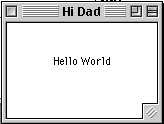
Example - Window EventsTypes of Events
windowActivated(WindowEvent)
WindowEventMethods getWindow()
Window Event Example
This example shows how to use a WindowListener to quit an application. Note that you cannot use System.exit(0) in an applet.
import java.awt.event.WindowEvent; import java.awt.event.WindowListener; import java.awt.Frame; import java.awt.Label; class QuitableApplication1 extends Frame { public QuitableApplication1( int left, int top, int width, int height, String title ) { super( title ); setSize( width, height ); setLocation( left, top); Label hello = new Label( "Hello World", Label.CENTER); add( hello, BorderLayout.CENTER ); addWindowListener( new QuitWindow( this ) ); show(); } } class QuitWindow implements WindowListener { Frame myWindow; public QuitWindow( Frame aWindow ) { myWindow = aWindow; } public void windowClosing(WindowEvent event) { myWindow.dispose(); System.exit(0); } public void windowActivated(WindowEvent event) {}; public void windowClosed(WindowEvent event) {}; public void windowDeactivated(WindowEvent event) {}; public void windowDeiconified(WindowEvent event) {}; public void windowIconified(WindowEvent event) {}; public void windowOpened(WindowEvent event) {}; }
WindowAdapter The WindowAdapter class implements, with null methods, all the methods in the WindowListener interface. By subclassing the WindowAdapter class, you can just implement the WindowListener methods you need.
import java.awt.event.WindowAdapter; import java.awt.event.WindowEvent; import java.awt.event.WindowListener; import java.awt.Frame; import java.awt.Label; class QuitableApplication2 extends Frame { public QuitableApplication2( int left, int top, int width, int height, String title ) { super( title ); setSize( width, height ); setLocation( left, top); Label hello = new Label( "Hello World", Label.CENTER); add( hello, BorderLayout.CENTER ); addWindowListener( new QuitWindowAdapter( this ) ); show(); } } class QuitWindowAdapter extends WindowAdapter { Frame myWindow; public QuitWindowAdapter( Frame aWindow ) { myWindow = aWindow; } public void windowClosing( WindowEvent event ) { myWindow.dispose(); System.exit(0); } }
Using Anonymous Classes Using an anonymous class shortens the example. This use of anonymous classes is the main reason for adding them to the language.
import java.awt.event.WindowAdapter; import java.awt.event.WindowEvent; import java.awt.event.WindowListener; import java.awt.Frame; import java.awt.Label; class QuitableApplication3 extends Frame { public QuitableApplication3( int left, int top, int width, int height, String title ) { super( title ); setSize( width, height ); setLocation( left, top); Label hello = new Label( "Hello World", Label.CENTER); add( hello, BorderLayout.CENTER ); addWindowListener( new WindowAdapter( ) { public void windowClosing( WindowEvent event ) { dispose(); System.exit(0); } } ); show(); } }
Listening to Yourself This example shows how use an adapter to have a class listen to itself. This allows the class to handle its own events.
import java.awt.event.WindowAdapter; import java.awt.event.WindowEvent; import java.awt.event.WindowListener; import java.awt.Frame; import java.awt.Label; class QuitableApplication4 extends Frame { public QuitableApplication4( int left, int top, int width, int height, String title ) { super( title ); setSize( width, height ); setLocation( left, top); Label hello = new Label( "Hello World", Label.CENTER); add( hello, BorderLayout.CENTER ); addWindowListener( new WindowAdapter( ) { public void windowClosing( WindowEvent event ) { quit(); } } ); show(); } public void quit() { dispose(); System.exit( 0 ); } }
Overview of AWT Parts
Components
Components are basic UI things
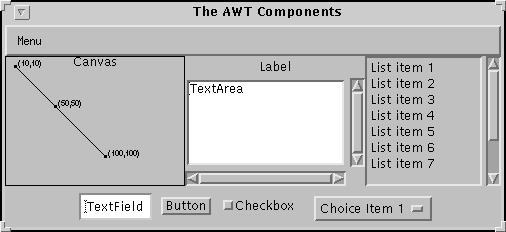 Buttons, Checkboxes, Choices, Lists, Menus, and Text Fields
Buttons, Checkboxes, Choices, Lists, Menus, and Text Fields
Component Classes
Containers: Windows and Panels
Containers contain components and containers
Window
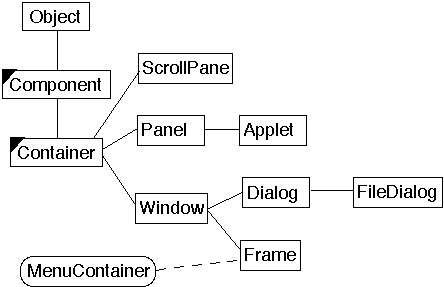
Component
|
Background
Color
|
void
setBackground( Color)
Color getBackground() |
|
Bounds |
void
setBounds( Rectangle )
void setBounds( int, int, int, int ) Rectangle getBounds() |
|
Cursor |
void
setCursor( Cursor )
Cursor getCursor() |
|
Drop
Target
|
void
setDropTarget(DropTarget)
DropTarget getDropTarget() |
|
Enabled |
void
setEnabled( boolean)
boolean getEnabled() |
|
Font |
void
setFont(Font )
Font getFont() |
|
Foreground
Color
|
void
setForeground( Color )
Color getForeground() |
|
Locale |
void
setLocale(Locale )
Locale getLocale() |
|
Location |
void
setLocation( Point )
void setLocation( int, int ) Point getLocation() Point getLocationOnScreen() |
|
Name |
void
setName( String )
String getName() |
|
Size |
void
setSize(Dimension )
Dimension getSize() |
|
Visible |
void
setVisible(boolean)
boolean getVisible() |
Layouts
We need to specify where items will appear in a window. This has to be done on window that changes size and on different platforms: PC, Mac, Unix, PDA, toasters, and TVs. Layouts provide a flexible way to place items in a window without specifying coordinates.
AWT Layouts
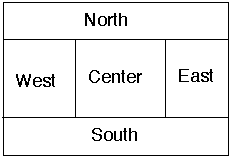
Button Examples
We will use buttons to illustrate some basics of layouts, components, and events.
FlowLayout This example creates a FlowLayout that aligns its components to the left. "new FlowLayout()" will create a FlowLayout that centers its components. Note how the buttons in the window "flow" as the window's shape is changed.
import java.awt.*; class FlowLayoutExample extends Frame { public FlowLayoutExample( int width, int height ) { setTitle( "Flow Example" ); setSize( width, height ); setLayout( new FlowLayout( FlowLayout.LEFT) ); for ( int label = 1; label < 10; label++ ) add( new Button( String.valueOf( label ) ) ); show(); } public static void main( String args[] ) { new FlowLayoutExample( 175, 100 ); } }
|
|
|
|
|
BorderLayout Since the BorderLayout is the default, we do not have to use the setLayout() method to specify the BorderLayout. It was done here just to insure that readers know that we are using the BorderLayout. Note how the layout deals the buttons as the window is resized.
import java.awt.*;
class BorderLayoutExample extends Frame { public BorderLayoutExample( int widthInPixels, int heightInPixels ) { setTitle( "BorderLayout Example" ); setSize( widthInPixels, heightInPixels ); setLayout( new BorderLayout() ); add( new Button( "North" ), BorderLayout.NORTH ); add( new Button( "Center" ), BorderLayout.CENTER ); add( new Button( "East" ), BorderLayout.EAST ); add( new Button( "West" ), BorderLayout.WEST ); add( new Button( "South" ), BorderLayout.SOUTH ); show(); } public static void main( String args[] ) { new BorderLayoutExample( 175, 100 ); } }
 |
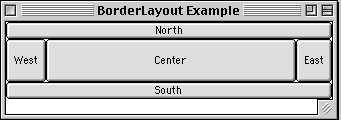 |
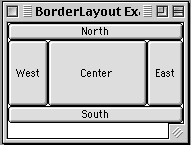 |
Button Events
Buttons support ActionListeners. When the mouse is pressed and released on a button, all listeners are send the actionPerformed() method. In this example we only need to know when the button was selected, so we do not use the ActionEvent.
import java.awt.*; import java.awt.event.ActionListener; import java.awt.event.ActionEvent; class ButtonExample extends Frame { Button red = new Button( "Red" ); Button blue = new Button( "Blue" ); public ButtonExample( int widthInPixels, int heightInPixels ) { setTitle( "Button Example" ); setSize( widthInPixels, heightInPixels ); setLayout( new FlowLayout() ); add( red ); add( blue ); red.addActionListener( new ColorActionListener( Color.red) ); blue.addActionListener( new ColorActionListener( Color.blue) ); show(); } public static void main( String args[] ){ ButtonExample window = new ButtonExample(200, 50); } class ColorActionListener implements ActionListener { Color backgroundColor; public ColorActionListener( Color aColor ) { backgroundColor = aColor; } public void actionPerformed( ActionEvent event ) { setBackground( backgroundColor ); repaint(); // Show effect of color change } } }
Button ActionEvent This example, which takes two slides, show how to use the ActionEvent.
import java.awt.*; import java.awt.event.ActionListener; import java.awt.event.ActionEvent; class ActionEventDataExample extends Frame { Button left = new Button( "Left" ); Button right = new Button( "Right" ); public ActionEventDataExample( int widthInPixels, int heightInPixels ) { setTitle( "Button Example" ); setSize( widthInPixels, heightInPixels ); setLayout( new FlowLayout() ); add( left ); add( right ); left.addActionListener( new ActionData( ) ); right.addActionListener( new ActionData( ) ); show(); } public static void main( String args[] ){ ActionEventDataExample window = new ActionEventDataExample(200, 50); }
Button ActionEvent Continued
class ActionData implements ActionListener { public void actionPerformed( ActionEvent event ) { String command = event.getActionCommand(); int modifiers = event.getModifiers(); String parameters = event.paramString(); System.out.println( "Command " + command); System.out.println( "Parameters " + parameters); switch ( modifiers ) { case ActionEvent.ALT_MASK: System.out.println( "Alt Key was pressed"); break; case ActionEvent.CTRL_MASK: System.out.println( "Control Key was pressed"); break; case ActionEvent.META_MASK: System.out.println( "Meta Key was pressed"); break; case ActionEvent.SHIFT_MASK: System.out.println( "Shift Key was pressed"); break; default: System.out.println( "No modifier keys were pressed"); } } } }Output
Custom Buttons We can create subclasses of Button, which will add functionality to the basic Button class.
import java.awt.*; import java.awt.event.ActionListener; import java.awt.event.ActionEvent; class CountButton extends Button implements ActionListener { int count = 0; public CountButton() { super( "0" ); addActionListener( this ); } public void actionPerformed( ActionEvent event ) { if (event.getSource() == this ) { count++; setLabel( String.valueOf( count ) ); } } } class SpecialButtonExample extends Frame { public SpecialButtonExample( int widthInPixels, int heightInPixels ) { setTitle( "Button Example" ); setSize( widthInPixels, heightInPixels ); setLayout( new FlowLayout() ); add( new CountButton() ); show(); } public static void main( String args[] ){ SpecialButtonExample window = new SpecialButtonExample(200, 50); } }Output (after a number of mouse clicks) 
Containers
Panels
Panels allow use of one layout inside of another layout. A panel is a container, so it holds components. A panel has a layout. The default layout for all panels is FlowLayout. Mixing layouts increases the flexibility of layouts. In the example below, a panel full of buttons is added to the north region of a Borderlayout.
import java.awt.*; class PanelExample extends Frame { public PanelExample( int widthInPixels, int h eightInPixels ) { setTitle( "Panel Example" ); setSize( widthInPixels, heightInPixels ); setLayout( new BorderLayout() ); Panel buttonDisplay = new Panel(); buttonDisplay.setLayout( new FlowLayout() ); for ( int label = 1; label < 6; label++ ) buttonDisplay.add( new Button( String.valueOf( label )) ); add( buttonDisplay, BorderLayout.NORTH ); add( new Button( "Center" ) , BorderLayout.CENTER ); add( new Scrollbar( Scrollbar.VERTICAL ), BorderLayout.EAST ); add( new Scrollbar( Scrollbar.HORIZONTAL ) , BorderLayout.SOUTH ); show(); } public static void main( String args[] ) { new PanelExample( 175, 100 ); } }
Result of Panel Example
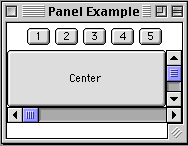
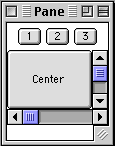
Note that the buttons do not wrap to second row of buttons event though they are in a FlowLayout! The FlowLayout is in north part of a BorderLayout. Only one row is available!
Label
Label provides a way to display text on the screen. It does not support any events other that those supported by the Component class.
Label Constructors
Label()
| CENTER | LEFT | RIGHT |
|
addNotify() |
paramString() |
|
getAlignment() |
setAlignment(int) |
|
getText() |
setText(String) |
Label Example
class LabelExample extends Frame { public LabelExample( int widthInPixels, int heightInPixels ) { setTitle( "Label Example" ); setSize( widthInPixels, heightInPixels ); setLayout( new GridLayout(5, 1) ); add( new Label( "Hi Mom" ) ); add( new Label( "Hi Dad", Label.CENTER ) ); add( new Label( "Good Bye", Label.RIGHT ) ); add( new Label( "Good Luck", Label.LEFT ) ); Font largeFont = new Font( "TimesRoman", Font.ITALIC, 24 ); Label largeText = new Label( "Large Font" ); largeText.setFont( largeFont ); add( largeText ); show(); } public static void main( String args[] ) { new LabelExample(150, 100); } }Output
Button
Button supports the ActionEvent.
|
Component |
Events
|
Meaning |
|
Button |
ActionEvent |
Button
clicked
|
|
Event
Class
|
Listener
Interface
|
Listener
Methods
|
|
ActionEvent |
ActionListener |
actionPerformed() |
class ButtonTextExample extends Frame {
public ButtonTextExample( int widthInPixels, int heightInPixels) {
setTitle( "Button Example" );
setSize( widthInPixels, heightInPixels );
setLayout( new FlowLayout() );
Font largeFont = new Font( "TimesRoman", Font.ITALIC, 24 );
Button largeText = new Button( "Large Font" );
largeText.setFont( largeFont );
add( largeText );
show();
}
public static void main( String args[] ) {
new ButtonTextExample(150, 100);
}
}

Choice - Drop-down Lists
|
Component |
Events
|
Meaning |
|
Choice |
ItemEvent |
Item
selected or deselected
|
|
Event
Class
|
Listener
Interface
|
Listener
Methods
|
|
ItemEvent |
ItemListener |
itemStateChanged() |
|
add(String)
addItem(String) addItemListener(ItemListener) removeItemListener(ItemListener) getItem(int) getItemCount() |
getSelectedIndex()
getSelectedItem()
getSelectedObjects() insert(String, int) paramString() remove(int) |
remove(String)
removeAll() select(int) select(String) |
Choice Example import java.awt.*; import java.awt.event.*; class ChoiceBoxes extends Frame { Choice directions = new Choice(); public ChoiceBoxes( int widthInPixels, int heightInPixels ) { setTitle( "ChoiceBox Example" ); setSize( widthInPixels, heightInPixels ); setLayout( new FlowLayout() ); directions.addItem( "Left" ); directions.addItem( "Right" ); directions.addItem( "Up" ); directions.addItem( "Down" ); directions.addItemListener( new ChoiceListener() ); add( directions ); show(); } class ChoiceListener implements ItemListener { int count = 1; public void itemStateChanged( ItemEvent event ) { Choice selected = (Choice) event.getItemSelectable(); int selectedIndex = selected.getSelectedIndex(); String selectedText = selected.getSelectedItem(); System.out.println( "Selected index: " + selectedIndex); System.out.println( "Selected string: " + selectedText ); selected.insert( String.valueOf( count++ ), selectedIndex ); selected.remove( selectedText ); } } public static void main( String args[] ) { new ChoiceBoxes(200, 200); } }
Choice Example ContinuedOutput

|
|

|

|
List
|
Component |
Events
|
Meaning |
|
List |
ActionEvent |
List
item doubled clicked
|
|
|
ItemEvent |
List
item selected or deselected
|
|
Event
Class
|
Listener
Interface
|
Listener
Methods
|
|
ActionEvent |
ActionListener |
actionPerformed() |
|
ItemEvent |
ItemListener |
itemStateChanged() |
|
add(String)
add(String, int) addActionListener(ActionListener) addItem(String) addItem(String, int) addItemListener(ItemListener) addNotify() delItem(int) deselect(int) getItem(int) getItemCount() getItems() getMinimumSize() |
getMinimumSize(int)
getPreferredSize() getPreferredSize(int) getRows() getSelectedIndex() getSelectedIndexes() getSelectedItem() getSelectedItems() getSelectedObjects() getVisibleIndex() isIndexSelected(int) isMultipleMode() makeVisible(int) |
paramString()
remove(int) remove(String) removeActionListener(ActionListener) removeAll() removeItemListener(ItemListener) removeNotify() replaceItem(String, int) select(int) setMultipleMode(boolean) |
List Example import java.awt.*; import java.awt.event.*; class ListExample extends Frame { public ListExample( int widthInPixels, int heightInPixels ) { setTitle( "List Box Example" ); setSize( widthInPixels, heightInPixels ); setLayout( new FlowLayout() ); boolean areMultipleSelectionsAllowed = false; int numberDisplayed = 4; List directions = new List( numberDisplayed, areMultipleSelectionsAllowed ); directions.addItem( "Left" ); directions.addItem( "Right" ); directions.addItem( "Up" ); directions.addItem( "Down" ); directions.addItemListener( new ListListener() ); add( directions ); show(); }
List Example
class ListListener implements ItemListener { public void itemStateChanged( ItemEvent event ) { List selected = (List) event.getItemSelectable(); int selectedIndex = selected.getSelectedIndex(); String selectedText = selected.getSelectedItem(); System.out.println( "Selected index: " + selectedIndex); System.out.println( "Selected string: " + selectedText ); } } public static void main( String args[] ) { new ListExample(200, 100); } }Output
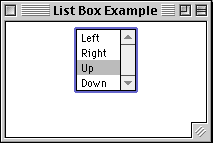
|

|
TextArea
A TextArea is a scrollable region that users can enter text. A TextArea can contain multiple rows and columns of text. The number of characters that can fit on one row depends on the font, font size and number of columns.
|
Component |
Events
|
Meaning |
|
TextComponent |
TextEvent |
User
changed text
|
|
Event
Class
|
Listener
Interface
|
Listener
Methods
|
|
TextEvent |
TextListener |
textValueChanged() |
addNotify() append(String) getColumns() getMinimumSize() getMinimumSize(int, int) getPreferredSize() getPreferredSize(int, int) |
getRows() getScrollbarVisibility() insert(String, int) paramString() replaceRange(String, int, int) setColumns(int) setRows(int) |
TextArea Example import java.awt.*; import java.awt.event.*; class TextAreas extends Frame { TextArea userInput; Button done = new Button( "Done Typing" ); public TextAreas( int widthInPixels, int heightInPixels ) { setTitle( "Text Area Example" ); setSize( widthInPixels, heightInPixels ); setLayout( new FlowLayout() ); int numberOfLines = 3; int numberOfColumns = 30; userInput = new TextArea( numberOfLines, numberOfColumns ); add( userInput ); add( done ); done.addActionListener( new ActionListener() { public void actionPerformed( ActionEvent event ) { checkUserInput(); } }); show(); } private void checkUserInput() { System.out.println( "You typed: " + userInput.getText() ); System.out.println( "Selected text>" + userInput.getSelectedText() +"<" ); userInput.setText( "Hi Mom"); } public static void main( String args[] ) { new TextAreas(300, 150); } }
Output
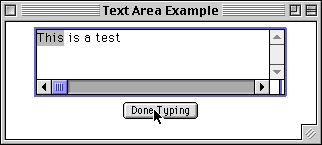 |
|
|
|
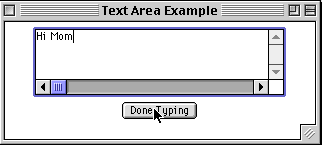 |
TextField
A TextField is a region that users can enter text. A TextField contains only one row of text. The number of characters that can be seen in a TextField depends on the font, font size and number of columns.
|
Component |
Events
|
Meaning |
|
TextComponent |
TextEvent |
User
changed text
|
|
TextField |
ActionEvent |
User
finished editing text
|
|
Event
Class
|
Listener
Interface
|
Listener
Methods
|
|
ActionEvent |
ActionListener |
actionPerformed() |
|
TextEvent |
TextListener |
textValueChanged() |
addActionListener(ActionListener) removeActionListener(ActionListener) addNotify() echoCharIsSet() getColumns() getEchoChar() getMinimumSize() |
getMinimumSize(int) getPreferredSize() getPreferredSize(int) paramString() setColumns(int) setEchoChar(char) |
TextField Example class TextFieldExample extends Frame { TextField firstName; TextField lastName; Button done = new Button( "Done Typing" ); public TextFieldExample( int widthInPixels, int heightInPixels ) { setTitle( "Text Field Example" ); setSize( widthInPixels, heightInPixels ); setLayout( new GridLayout(3, 1) ); int numberOfColumns = 10; firstName = new TextField( numberOfColumns ); Panel first = new Panel( new FlowLayout() ); first.add( new Label( "First name", Label.RIGHT )); first.add( firstName ); lastName = new TextField( numberOfColumns ); Panel last = new Panel( new FlowLayout() ); last.add( new Label( "Last name", Label.RIGHT ) ); last.add( lastName ); Panel buttons = new Panel( new FlowLayout( FlowLayout.CENTER)); buttons.add( done ); add( first ); add( last ); add( buttons );
TextField Example Continued
// Called when user hits the enter key firstName.addActionListener( new ActionListener() { public void actionPerformed( ActionEvent event ) { System.out.println( "Action Event " + event.getActionCommand() ); } }); // Called when button is pressed. done.addActionListener( new ActionListener() { public void actionPerformed( ActionEvent event ) { System.out.println("Your name is: " + firstName.getText() +" " + lastName.getText() ); } }); show(); } public static void main( String args[] ) { new TextFieldExample(300, 150); } }
|
|
|
Dialogs
Dialogs can be either modal or nonmodal.
Modal
A modal dialog blocks:
|
getTitle()
isModal() isResizable() |
paramString()
setModal(boolean) setResizable(boolean) |
setTitle(String)
show() |
Dialog Example On this slide, a LoginDialog class is defined. On the next slide, it is used.
import java.awt.*; import java.awt.event.*; class LoginDialog extends Dialog { TextField password; Button done = new Button( "OK" ); public LoginDialog( Frame owner ) { super( owner, "Log in", true ); setSize( 200, 100 ); setLocation( 50, 50 ); setLayout( new GridLayout(2, 1) ); int numberOfColumns = 10; password = new TextField( numberOfColumns ); password.setEchoChar( '*' ); password = new TextField( numberOfColumns ); Panel first = new Panel( new FlowLayout() ); first.add( new Label( "Password", Label.RIGHT )); first.add( password ); Panel buttons = new Panel( new FlowLayout( FlowLayout.CENTER)); buttons.add( done ); add( first ); add( buttons ); done.addActionListener( new ActionListener() { public void actionPerformed( ActionEvent event ) { setVisible(false); } }); } public String getPassword() { return password.getText(); } }
Dialog Example Continued
class DialogExample extends Frame { public DialogExample( int widthInPixels, int heightInPixels ) { setTitle( "Text Validation Example" ); resize( widthInPixels, heightInPixels ); setLayout( new FlowLayout() ); Button login = new Button( "Log in" ); login.addActionListener( new Login() ); add( login ); show(); } public static void main( String args[] ) { new DialogExample(100, 50); } class Login implements ActionListener { public void actionPerformed( ActionEvent event ) { LoginDialog passwordDialog = new LoginDialog( DialogExample.this ); passwordDialog.show( ); System.out.println( "Password is: " + passwordDialog.getPassword() ); } } }
Dialog Example Continued
|
|
|